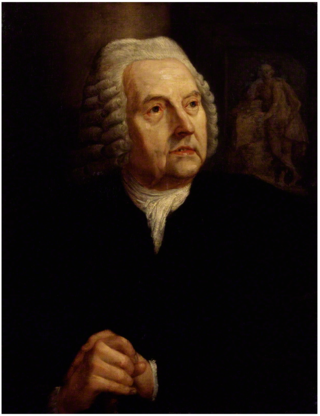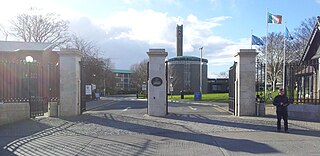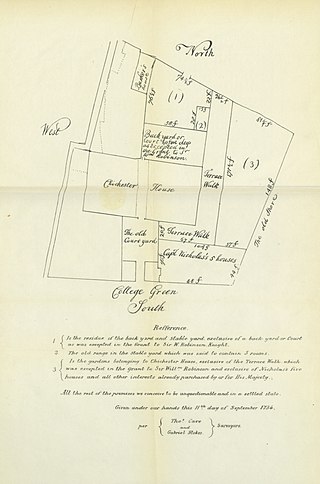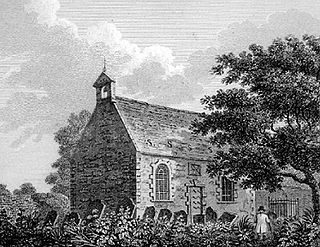
Peter Scheemakers or Pieter Scheemaeckers II or the Younger was a Flemish sculptor who worked for most of his life in London. His public and church sculptures in a classicist style had an important influence on the development of modern sculpture in England.

Henrietta Street is a Dublin street, to the north of Bolton Street on the north side of the city, first laid out and developed by Luke Gardiner during the 1720s. A very wide street relative to streets in other 18th-century cities, it includes a number of very large red-brick city palaces of Georgian design.

St Patrick's College, often known as St Pat's, was a third level institution in Ireland, the leading function of which was as the country's largest primary teacher training college, which had at one time up to 2,000 students. Founded in Drumcondra, in the northern suburbs of Dublin, in 1875, with a Roman Catholic ethos, it offered a number of undergraduate courses, primarily in primary education and arts, and in time postgraduate courses too, mostly in education and languages.

All Hallows College was a college of higher education in Dublin. It was founded in 1842 and was run by the Vincentians from 1892 until 2016. On 23 May 2014, it was announced that it was closing because of declining student enrollment. The sale of the campus in Drumcondra to Dublin City University was announced on 19 June 2015 and completed on 8 April 2016. The college closed on 30 November 2016, becoming the All Hallows Campus of Dublin City University.

Drumcondra is a residential area and inner suburb on the Northside of Dublin, Ireland. It is administered by Dublin City Council. The River Tolka and the Royal Canal flow through the area.
Sir Edward Lovett Pearce was an Irish architect, and the chief exponent of Palladianism in Ireland. He is thought to have initially studied as an architect under his father's first cousin, Sir John Vanbrugh. He is best known for the Irish Houses of Parliament in Dublin, and his work on Castletown House. The architectural concepts he employed on both civic and private buildings were to change the face of architecture in Ireland. He could be described as the father of Irish Palladian architecture and Georgian Dublin.

Richard Cassels, also known as Richard Castle, was an architect who ranks with Edward Lovett Pearce as one of the greatest architects working in Ireland in the 18th century. Cassels was born in 1690 in Kassel, Germany. Although German, his family were of French origin and descended from the French-Netherlandish 'Du Ry' family, famous for the many architects among their number. A cousin Simon Louis du Ry designed Schloss Wilhelmshöhe in Kassel.

Alessandro Maria Gaetano Galilei was an Italian mathematician, architect and theorist, and a distant relative of Galileo Galilei.

Chichester House or Carew's House was a building in College Green, Dublin, Ireland, used in the 17th century to house the Parliament of Ireland. Originally built to be a hospital, it was never used as such.
Events from the year 1729 in Ireland.
There have been two baronetcies created for persons with the surname Coghill, both in the Baronetage of Great Britain. One creation is extant as of 2008.

Drumcondra Church of Ireland is a Church of Ireland church located in Drumcondra, Dublin, previously in the Civil Parish of Clonturk. The church and its churchyard contain memorials to a number of notable historical figures.
Marmaduke Coghill (1673–1738) was a member of Parliament for Dublin University, judge of the Prerogative Court and Chancellor of the Exchequer of Ireland.
Clonturk is an area on the Northside of Dublin, in Ireland. It is located in the south of the suburb of Drumcondra, just north of the River Tolka, but previously, Clonturk had been an alternative name for Drumcondra and the wider area. Clonturk lies within the Dublin 9 postal district. The name Clonturk translates from the Irish as "Pasture of the boars". There is some evidence that the name originally was Ceann Torc or the "Headland of the boars", but had changed to Clonturk by the middle of the 16th century, perhaps under the influence of the more famous neighbouring placename Clontarf.
Charles Moore, 1st Earl of Charleville PC, known as The Lord Moore between 1725 and 1758, was an Irish peer and freemason.

Summerhill House was a 100-roomed Palladian house in County Meath, Ireland which was the ancestral seat of the Viscounts Langford and the Barons Langford. Built in 1731, it was likely designed by Sir Edward Lovett Pearce and completed by Richard Cassels in the Palladian style, although Sir John Vanbrugh, who was related to Pearce and with whom he trained, is thought to have also influenced the design of the house, which could be seen by the great arched chimney stacks and the palatial grandeur and scale.
John Bathe (1536-1586) was an Irish lawyer and statesman of the sixteenth century. He held several important offices, including that of Attorney General for Ireland and Chancellor of the Exchequer of Ireland. He was a member of a prominent landowning family from County Dublin, and himself added to the family estates. His children included the Jesuit William Bathe, who was a noted musicologist.
Sir John Coghill, 1st Baronet, known before 1775 as John Cramer, was an Anglo-Irish politician.
Sir John Coghill, 1st Baronet, also known as John Mayne, was a British Army officer and Tory politician.
O’Donnell House was erected in Drumcondra in honour of the memory of Fr. Thomas O'Donnell (1864-1949), who served as President of All Hallows College from 1920 to 1948, and is now a part of the expanded campus of Dublin City University. It was originally part of the former All Hallows College, created in 1842 by Fr. John Hand (1807-1846), and run by the Vincentians order of priests as a seminary to educate future Roman Catholic missionaries to serve abroad. That college closed in 2016, and the premises became the All Hallows Campus of Dublin City University, a university established in Glasnevin, Dublin, since 1989.












